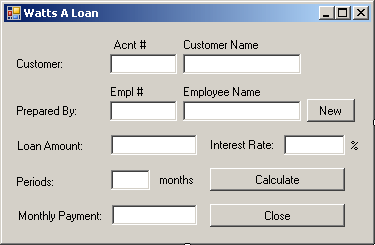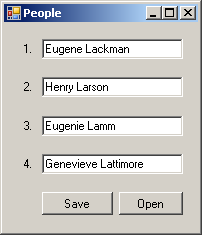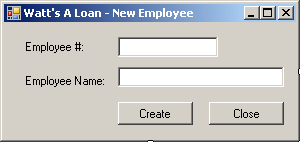 |
Microsoft Visual C# File Processing: File Information |
|
|
|
In its high level of support for file processing, the
.NET Framework provides a class named FileInfo. This class is
equipped to handle all types of file-related operations including creating,
copying, moving, renaming, or deleting a file. FileInfo is based on
the FileSystemInfo class that provides information on characteristics
of a file.
|
|
 Application:
Introducing File Information Application:
Introducing File Information
|
|
- To start a new application, on the main menu, click File -> New Project
- In the middle list, click Windows Application
- Set the name to WattsALoan1
- In the Properties window, change the form's Text to Watts
A Loan
- To be able to use the Visual Basic library, in the Solution
Explorer, right-click WattsALoan1 and click Add Reference...
- In the .NET property page, click Microsoft.VisualBasic

- Click OK
- Design the form as follows:
 |
| Control |
Name |
Text |
| Label |
|
Acnt #: |
| Label |
|
Customer Name: |
| Label |
|
Customer: |
| TextBox |
txtAccountNumber |
|
| TextBox |
txtCustomerName |
|
| Label |
|
Empl #: |
| Label |
|
Employee Name: |
| Label |
|
Prepared By: |
| TextBox |
txtEmployeeNumber |
|
| TextBox |
txtEmployeeName |
|
| Button |
btnNewEmployee |
|
| Label |
|
Loan Amount: |
| TextBox |
txtLoanAmount |
|
| Label |
|
Interest Rate: |
| TextBox |
txtInterestRate |
|
| Label |
|
% |
| Label |
|
Periods |
| TextBox |
|
txtPeriods |
| Button |
btnCalculate |
Calculate |
| Label |
|
Monthly Payment: |
| TextBox |
txtMonthlyPayment |
|
| Button |
btnClose |
Close |
|
- Double-click the Calculate button and implement its event as
follows:
private void btnCalculate_Click(object sender, EventArgs e)
{
double LoanAmount = 0.00D,
InterestRate = 0.00D,
Periods = 0.00D,
MonthlyPayment = 0.00D;
try
{
LoanAmount = double.Parse(txtLoanAmount.Text);
}
catch (FormatException)
{
MessageBox.Show("Invalid Loan Amount");
}
try
{
InterestRate = double.Parse(txtInterestRate.Text);
}
catch (FormatException)
{
MessageBox.Show("Invalid Interest Rate");
}
try
{
Periods = double.Parse(txtPeriods.Text);
}
catch (FormatException)
{
MessageBox.Show("Invalid Periods Value");
}
try
{
MonthlyPayment =
Microsoft.VisualBasic.Financial.Pmt(InterestRate/12/100,
Periods,
-LoanAmount,
0,
Microsoft.VisualBasic.DueDate.BegOfPeriod);
txtMonthlyPayment.Text = MonthlyPayment.ToString("F");
}
catch (FormatException)
{
MessageBox.Show("Invalid Periods Value");
}
}
- Return to the form and double-click the Close button to implement
its event as follows:
private void btnClose_Click(object sender, EventArgs e)
{
Close();
}
- Return to the form
|
Initializing File
Information
|
|
The FileInfo class is equipped with one
constructor whose syntax is:
public FileInfo(String fileName);
This constructor takes as argument the name of a file or
its complete path. If you provide only the name of the file, the compiler
would consider the same directory of its project. Here is an example:
public partial class Exercise : Form
{
private void btnSave_Click(object sender, EventArgs e)
{
FileInfo flePeople = new FileInfo("People.txt");
}
}
Alternatively, if you want, you can provide any valid
directory you have access to. In this case, you should provide the complete
path.
|
 Application:
Initializing a File Application:
Initializing a File
|
|
- Double-click an unoccupied area on the body form
- Scroll up completely and, under the other using lines, type using
System.IO;
- Scroll down complement and change the Load event of the form as
follows:
private void Form1_Load(object sender, EventArgs e)
{
string strFilename = "Employees.wal";
FileInfo fiEmployees = new FileInfo(strFilename);
}
After creating a file, you can write one or more values
to it. An example of a value is text. If you want to create a file that
contains text, the FileInfo class provides a method named
CreateText . Its syntax is:
public StreamWriter CreateText();
This method returns a StreamWriter object. You
can use this returned object to write text to the file.
|
 Application:
Creating a Text File Application:
Creating a Text File
|
|
|
Writing a Value to a File
|
|
To write normal text to a file, you can first call the
FileInfo.CreateText() method. This method returns a StreamWriter
object. The StreamWriter class is based on the TextWriter
class that is equipped with the Write() and the WriteLine()
methods used to write values to a file. The Write() method writes
text on a line and keeps the caret on the same line. The WriteLine()
method writes a line of text and moves the caret to the next line.
After writing to a file, you should close the
StreamWriter object to free the resources it was using during its
operation(s). Here is an example:

private void btnSave_Click(object sender, EventArgs e)
{
FileInfo flePeople = new FileInfo("People.txt");
StreamWriter stwPeople = flePeople.CreateText();
try
{
stwPeople.WriteLine(txtPerson1.Text);
stwPeople.WriteLine(txtPerson2.Text);
stwPeople.WriteLine(txtPerson3.Text);
stwPeople.WriteLine(txtPerson4.Text);
}
finally
{
stwPeople.Close();
txtPerson1.Text = "";
txtPerson2.Text = "";
txtPerson3.Text = "";
txtPerson4.Text = "";
}
}
|
 Application:
Writing to a Text File Application:
Writing to a Text File
|
|
- Change the Load event of the form as follows:
private void Form1_Load(object sender, EventArgs e)
{
string strFilename = "Employees.wal";
FileInfo fiEmployees = new FileInfo(strFilename);
StreamWriter stwEmployees = fiEmployees.CreateText();
// And create a John Doe employee
try {
stwEmployees.WriteLine("00-000");
stwEmployees.WriteLine("John Doe");
}
finally
{
stwEmployees.Close();
}
}
You may have created a text-based file and written to
it. If you open such a file and find out that a piece of information is
missing, you can add that information to the end of the file. To do this,
you can call the FileInfo.AppenText() method. Its syntax is:
public StreamWriter AppendText();
When calling this method, you can retrieve the
StreamWriter object that it returns, then use that object to add new
information to the file.
|
 Application:
Writing to a Text File Application:
Writing to a Text File
|
|
- To create a new form, on the main menu, click Project -> Add Windows
Form...
- In the middle list, make sure Windows Form is selected. Set the Name
to NewEmployee and click Add
- Design the form as follows:
 |
| Control |
Text |
Name |
| Label |
Employee #: |
|
| TextBox |
|
txtEmployeeNumber |
| Label |
Employee Name: |
|
| TextBox |
|
txtEmployeeName |
| Button |
Create |
btnCreate |
| Button |
Close |
btnClose |
|
- Right-click the form and click View Code
- In the top section of the file, under the using using lines, type
using System.IO;
- Return to the New Employee form and double-click the Create button
- Implement its event as follows:
private void btnCreate_Click(object sender, EventArgs e)
{
string strFilename = "Employees.wal";
FileInfo fiEmployees = new FileInfo(strFilename);
StreamWriter stwEmployees = null;
stwEmployees= fiEmployees.AppendText();
try {
stwEmployees.WriteLine(txtEmployeeNumber.Text);
stwEmployees.WriteLine(txtEmployeeName.Text);
}
finally
{
stwEmployees.Close();
}
txtEmployeeNumber.Text = "";
txtEmployeeName.Text = "";
txtEmployeeNumber.Focus();
}
- Return to the New Employee form and double-click the Close button
- Implement its event as follows:
private void btnClose_Click(object sender, EventArgs e)
{
Close();
}
- Access the Form1 form
- Double-click the top New button and implement the event as follows:
private void btnNewEmployee_Click(object sender, EventArgs e)
{
NewEmployee frmNewEmployee = new NewEmployee();
frmNewEmployee.ShowDialog();
}
- Return to the form
- In the combo box on top of the Properties window, select
txtEmployeeNumber
- On the Properties window, click the Events button and double-click
Leave
- Implement the event as follows:
private void txtEmployeeNumber_Leave(object sender, EventArgs e)
{
string strFilename = "Employees.wal";
FileInfo fiEmployees = new FileInfo(strFilename);
if (txtEmployeeNumber.Text == "")
{
txtEmployeeName.Text = "";
return;
}
else
{
StreamReader strEmployees = fiEmployees.OpenText();
string strEmployeeNumber, strEmployeeName;
bool found = false;
try
{
using (strEmployees = new StreamReader(strFilename))
{
while (strEmployees.Peek() >= 0)
{
strEmployeeNumber = strEmployees.ReadLine();
if (strEmployeeNumber == txtEmployeeNumber.Text)
{
strEmployeeName = strEmployees.ReadLine();
txtEmployeeName.Text = strEmployeeName;
found = true;
}
}
}
// When the application has finished checking the file
// if there was no employee with that number, let the user know
if (found == false)
{
MessageBox.Show("No employee with that number was found");
txtEmployeeName.Text = "";
txtEmployeeNumber.Focus();
}
}
finally
{
strEmployees.Close();
}
}
}
- Execute the application to test it
- First create a few employees as follows:
| Employee # |
Employee Name |
| 42-806 |
Patricia Katts |
| 75-148 |
Helene Mukoko |
| 36-222 |
Frank Leandro |
| 42-808 |
Gertrude Monay |
- Process a loan

- Close the application
As opposed to writing to a file, you can read from it.
To support this, the FileInfo class is equipped with a method named
OpenText(). Its syntax is:
public StreamReader OpenText();
This method returns a StreamReader object. You
can then use this object to read the lines of a text file. Here is an
example:
using System;
using System.Collections.Generic;
using System.ComponentModel;
using System.Data;
using System.Drawing;
using System.Linq;
using System.Text;
using System.Windows.Forms;
namespace FileProcessing2
{
public partial class Exercise : Form
{
public Exercise()
{
InitializeComponent();
}
private void btnSave_Click(object sender, EventArgs e)
{
FileInfo flePeople = new FileInfo("People.txt");
StreamWriter stwPeople = flePeople.CreateText();
try
{
stwPeople.WriteLine(txtPerson1.Text);
stwPeople.WriteLine(txtPerson2.Text);
stwPeople.WriteLine(txtPerson3.Text);
stwPeople.WriteLine(txtPerson4.Text);
}
finally
{
stwPeople.Close();
txtPerson1.Text = "";
txtPerson2.Text = "";
txtPerson3.Text = "";
txtPerson4.Text = "";
}
}
private void btnOpen_Click(object sender, EventArgs e)
{
string Filename = "People.txt";
FileInfo flePeople = new FileInfo(Filename);
StreamReader strPeople = flePeople.OpenText();
try
{
txtPerson1.Text = strPeople.ReadLine();
txtPerson2.Text = strPeople.ReadLine();
txtPerson3.Text = strPeople.ReadLine();
txtPerson4.Text = strPeople.ReadLine();
}
finally
{
strPeople.Close();
}
}
}
}
|
|





